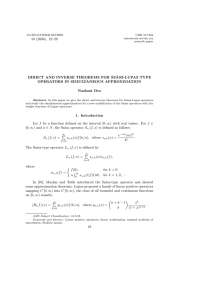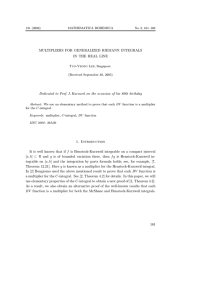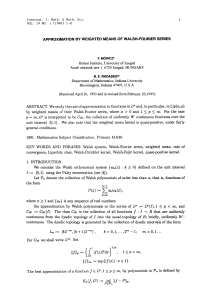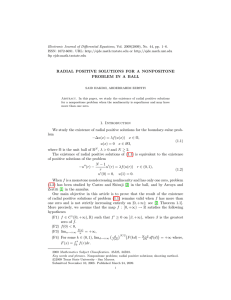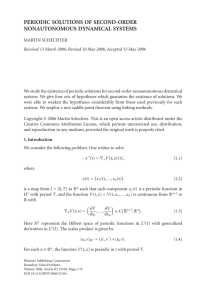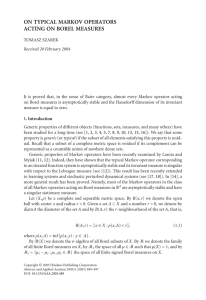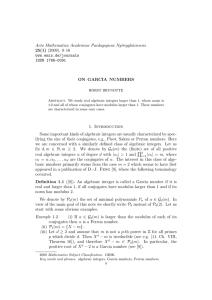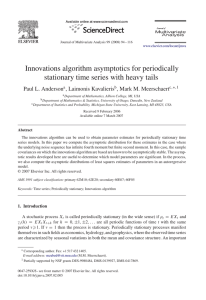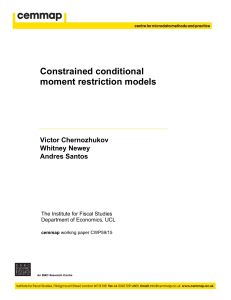Bulletin of Mathematical Analysis and Applications ISSN: 1821-1291, URL:
advertisement
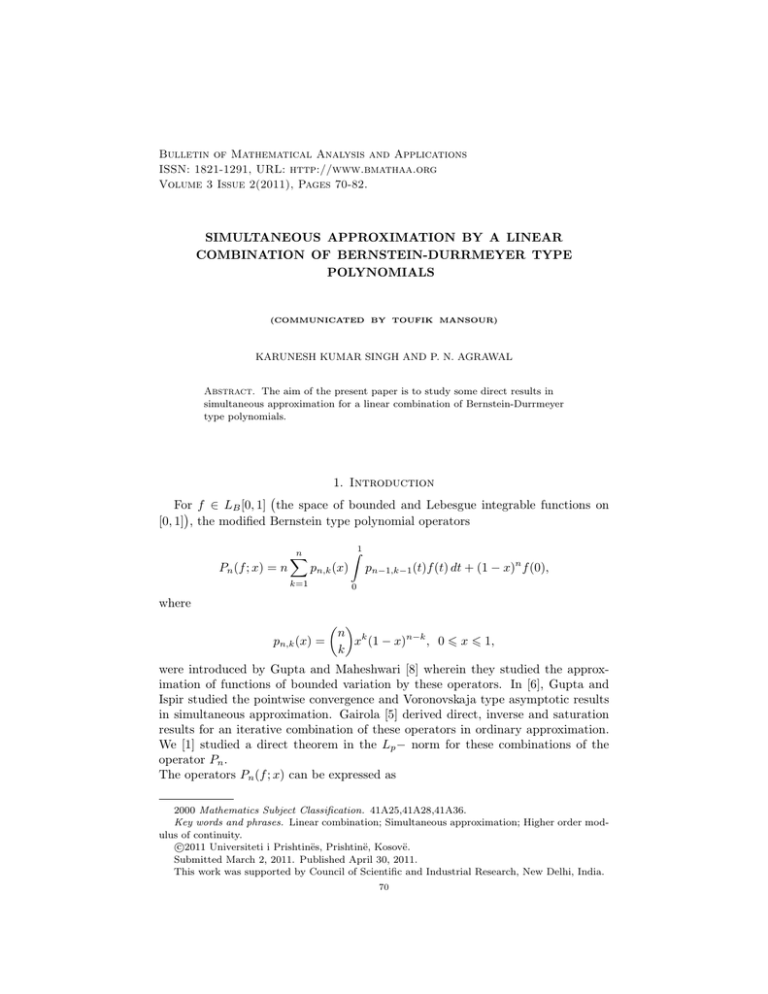
Bulletin of Mathematical Analysis and Applications
ISSN: 1821-1291, URL: http://www.bmathaa.org
Volume 3 Issue 2(2011), Pages 70-82.
SIMULTANEOUS APPROXIMATION BY A LINEAR
COMBINATION OF BERNSTEIN-DURRMEYER TYPE
POLYNOMIALS
(COMMUNICATED BY TOUFIK MANSOUR)
KARUNESH KUMAR SINGH AND P. N. AGRAWAL
Abstract. The aim of the present paper is to study some direct results in
simultaneous approximation for a linear combination of Bernstein-Durrmeyer
type polynomials.
1. Introduction
(
For
) f ∈ LB [0, 1] the space of bounded and Lebesgue integrable functions on
[0, 1] , the modified Bernstein type polynomial operators
Pn (f ; x) = n
n
∑
∫1
pn−1,k−1 (t)f (t) dt + (1 − x)n f (0),
pn,k (x)
k=1
0
where
pn,k (x) =
( )
n k
x (1 − x)n−k , 0 6 x 6 1,
k
were introduced by Gupta and Maheshwari [8] wherein they studied the approximation of functions of bounded variation by these operators. In [6], Gupta and
Ispir studied the pointwise convergence and Voronovskaja type asymptotic results
in simultaneous approximation. Gairola [5] derived direct, inverse and saturation
results for an iterative combination of these operators in ordinary approximation.
We [1] studied a direct theorem in the Lp − norm for these combinations of the
operator Pn .
The operators Pn (f ; x) can be expressed as
2000 Mathematics Subject Classification. 41A25,41A28,41A36.
Key words and phrases. Linear combination; Simultaneous approximation; Higher order modulus of continuity.
c
⃝2011
Universiteti i Prishtinës, Prishtinë, Kosovë.
Submitted March 2, 2011. Published April 30, 2011.
This work was supported by Council of Scientific and Industrial Research, New Delhi, India.
70
SIMULTANEOUS APPROXIMATION
71
∫1
Pn (f ; x) =
Wn (t, x)f (t) dt,
0
where the kernel of the operators is given by
n
∑
Wn (t, x) = n
pn,k (x) pn−1,k−1 (t) + (1 − x)n δ(t),
k=1
δ(t) being the Dirac-delta function.
It turns out that the order of approximation by these operators is at best O(n−1 ),
however smooth the function may be.
Following the technique of linear combination described in [3] to improve the order
of approximation, we define
Pn (f, k, x) =
k
∑
C(j, k)Pdj n (f, x),
j=0
where
C(j, k) =
k
∏
i=0,i̸=j
dj
, k ̸= 0 and C(0, 0) = 1,
dj − di
(1.1)
d0 , d1 , ...dk being (k + 1) arbitrary but fixed distinct positive integers.
The object of the present paper is to investigate some direct results in the simultaneous approximation by the operators Pn (., k, x). First we establish a Voronovskaja
type asymptotic formula and then obtain an error estimate in terms of local mod(r)
ulus of continuity of the function involved for the operator Pn (., k, x).
2. Auxiliary Results
In the sequel we shall require the following results:
Lemma 2.1. [6] For the function un,m (x), m ∈ N0 (the set of non-negative integers) defined as
un,m (x) =
n
∑
pn,ν (x)
(ν
ν=0
n
)m
−x
,
we have un,0 (x) = 1 and un,1 (x) = 0. Further, there holds the recurrence relation
[
]
nun,m+1 (x) = x u′n,m (x) + mun,m−1 (x) , m = 1, 2, 3, ...
Consequently,
(i) un,m (x) is a polynomial in x of degree [m/2], where [α] denotes the integral part
of α;
(
)
(ii) for every x ∈ [0, 1], un,m (x) = O n−[(m+1)/2] .
Remark 1. From the above lemma, we have
n
∑
ν=0
pn,ν (x) (ν − nx)
2j
= O(nj )
(2.1)
72
K. K. SINGH AND P. N. AGRAWAL
For m ∈ N0 (the set of non-negative integers), the mth order moment for the
operators Pn is defined as
µn,m (x) = Pn ((t − x)m ; x) .
Lemma 2.2. [1] For the function µn,m (x), we have µn,0 (x) = 1, µn,1 (x) =
and there holds the recurrence relation
(−x)
(n+1) ,
{
}
(n+m+1)µn,m+1 (x) = x(1−x) µ′n,m (x) + 2mµn,m−1 (x) +(m(1−2x)−x)µn,m (x),
for m ≥ 1.
Consequently, we have
(i) µn,m (x) is a polynomial in x of degree
m; )
(
(ii) for every x ∈ [0, 1], µn,m (x) = O n−[(m+1)/2] .
Remark 2. From the above lemma, it follows that for each x ∈ (0, 1),
n
n
∑
∫1
pn,k (x)
k=1
(
)
pn−1,k−1 (t)(t − x)m dt = O n−[(m+1)/2] , m ∈ N0 .
0
Lemma 2.3. If C(j, k), j = 0, 1, 2, ......., k is defined as in 1.1, then
k
∑
C(j, k)d−m
=
j
j=0
{
1, m = 0
0, m = 1, 2, 3, 4........
Lemma 2.4. For p ∈ N, Pn ((t − x)p , k, x) = n−(k+1) {Q(p, k, x) + o(1)} where
Q(p, k, x) are certain polynomials in x of degree at most p.
From Lemma 2.2 and Lemma 2.3 the above lemma easily follows hence the details
are omitted.
Throughout this paper, we assume 0 < a < b < 1, I = [a, b], 0 < a1 < a2 < b2 <
b1 < 1, Ii = [ai , bi ], i = 1, 2, [a1 , b1 ] ⊂ (a, b), ∥.∥C(I) the sup- norm on the interval
I and C a constant not necessarily the same at each occurrence.
Let f ∈ C[a, b]. Then, for a sufficiently small η > 0, the Steklov mean fη,m of m−th
order corresponding to f is defined as follows:
fη,m (t) = η
−m
∫η/2 ∫η/2 (
m
)∏
∑m
···
f (t) + (−1)m−1 ∆m
f
(t)
dti , , t ∈ I1 ,
i=1 ti
−η/2 −η/2
i=1
where ∆m
h is the m−th forward difference operator with step length h.
Lemma 2.5. Let f ∈ C[a, b]. Then, for the function fη,m , we have
(a) fη,m has derivatives up to order m over I1 ;
(r)
(b) ∥fη,m ∥C(I1 ) 6 Cr ωr (f, η, [a, b]), r = 1, 2, ..., m;
(c) ∥f − fη,m ∥C(I1 ) 6 Cm+1 ωm (f, η, [a, b]);
(d) ∥fη,m ∥C(I1 ) 6 Cm+2 η −m ∥f ∥C[a,b] ;
(r)
(e) ∥fη,m ∥C(I1 ) 6 Cm+3 ∥f ∥C[a,b] ,
where Ci′ s are certain constants that depend on i but are independent of f and η.
SIMULTANEOUS APPROXIMATION
73
Following ([9], Theorem 18.17) or ([10], pp.163-165), the proof of the above lemma
easily follows hence the details are omitted.
Lemma 2.6. [1] For the function pn,k (x), there holds the result
xr (1 − x)r
∑
dr pn,k (x)
=
ni (k − nx)j qi,j,r (x)pn,k (x),
r
dx
2i+j6r
i,j≥0
where qi,j,r (x) are certain polynomials in x independent of n and k.
Theorem 2.7. Let f ∈ LB [0, 1] admitting a derivative of order 2k + 2 at a point
x ∈ [0, 1] then we have
lim nk+1 [Pn (f, k, x) − f (x)] =
n→∞
2k+2
∑
ν=1
f (ν) (x)
Q(ν, k, x)
ν!
(2.2)
and
lim nk+1 [Pn (f, k + 1, x) − f (x)] = 0,
n→∞
(2.3)
where Q(ν, k, x) are certain polynomials in x of degree ν. Further, the limits in (2.2)
and (2.3) hold uniformly in [a, b] if f (2k+2) is continuous on (a − η, b + η) ⊂ (0, 1),
η > 0.
Proceeding along the lines of the proof of (Thm., [2]), the above theorem easily
follows. Hence the details are omitted.
3. Main Results
Theorem 3.1. Let f ∈ LB [0, 1] admitting a derivative of order 2k + r + 2 at a
point x ∈ (0, 1) then we have
lim nk+1 [Pn(r) (f, k, x) − f (r) (x)] =
2k+r+2
∑
n→∞
ν=r
f (ν) (x)
Q1 (ν, k, r, x)
ν!
(3.1)
and
lim nk+1 [Pn(r) (f, k + 1, x) − f (r) (x)] = 0,
n→∞
(3.2)
where Q1 (ν, k, r, x) are certain polynomials in x. Further, the limits in (3.1) and
(3.2) hold uniformly in [a, b] if f (2k+r+2) is continuous on (a − η, b + η) ⊂ (0, 1),
η > 0.
Proof. By a partial Taylor’s expansion of f , we have
f (t) =
2k+r+2
∑
ν=0
f (ν) (x)
(t − x)ν + ϵ(t, x)(t − x)2k+r+2 ,
ν!
where ϵ(t, x) → 0 as t → x. Thus, we can write
74
K. K. SINGH AND P. N. AGRAWAL
[
n
k+1
−f
[Pn(r) (f, k, x)
(r)
(x)] = n
2k+2+r
∑
k+1
ν=0
]
f (ν) (x) (r)
ν
(r)
Pn ((t − x) , k, x) − f (x)
ν!
k
∑
(r)
C(j, k)Pdj n (ϵ(t, x)(t − x)2k+r+2 ; x)
+
nk+1
=
Σ1 + Σ2 , say.
j=0
On an application of Lemma 2.2 and Theorem 2.7 we obtain
Σ1
= n
[2k+r+2
∑ f (ν) (x)
k+1
ν=0
ν=r
ν!
i
− x) , k, x) − f
i=0
[ 2k+r+2
ν ( )
∑ f (ν) (x) ∑
ν
ν!
ν=r
Dr xi + n−(k+1)
i=0
[ 2k+2
∑
j=1
= nk+1
[ 2k+r+2
∑
ν=r
+
ν!
ν
[2k+r+2
ν ( )
∑ f (ν) (x) ∑
ν
= nk+1
= nk+1
]
Pn(r) ((t
2k+r+2
∑
i
(
Dr
(r)
(x)
]
(−x)ν−i Pn(r) (ti , k, x) − f (r) (x)
(−x)ν−i ×
]
)
]
D j xi
(r)
Q(j, k, x) + o(1)
− f (x)
j!
]
ν ( )( )
f (ν) (x) ∑ ν
i
r!
(−1)ν−i (x)ν−r − f (r) (x)
ν!
i
r
i=0
Q1 (ν, k, r, x)f (ν) (x) + o(1),
ν=r
where we have used the identity
i
∑
(−1)l
l=0
( )( ) {
i
l
0,
i>r
=
(−1)r , i = r.
l
r
Thus, we get
Σ1 =
2k+r+2
∑
Q1 (ν, k, r, x)f (ν) (x) + o(1)
ν=r
In order to prove the assertion 3.1, it is sufficient to show that
nk+1 Pn(r) (ϵ(t, x)(t − x)2k+r+2 ; x) → 0 as n → ∞.
Σ
≡ Pn(r) (ϵ(t, x)(t − x)2k+r+2 ; x)
∫1
n
∑
(r)
= n
pn,k (x) pn−1,k−1 (t)ϵ(t, x)(t − x)2k+r+2 dt
k=1
0
n!
(1 − x)n−r ϵ(0, x)(−x)2k+r+2 .
+ (−1)r
(n − r)!
SIMULTANEOUS APPROXIMATION
75
Therefore, by using Lemma 2.6 we have
|Σ| ≤
∑
n
ni
n
|qi,j,r (x)| ∑
|k − nx|j pn,k (x) ×
xr (1 − x)r
k=1
2i+j≤r
i,j≥0
∫1
pn−1,k−1 (t)|ϵ(t, x)||t − x|2k+2+r dt
0
n!
+
(1 − x)n−r |ϵ(0, x)|x2k+r+2
(n − r)!
= J1 + J2 , say.
Since ϵ(t, x) → 0 as t → x, for a given ϵ′ > 0 we can find a δ > 0 such that
|ϵ(t, x)| < ϵ′ whenever 0 < |t − x| < δ and for |t − x| ≥ δ, |ϵ(t, x)| ≤ K for some
K > 0. Hence
|J1 | ≤
∑
nC1
ni
|k − nx|j pn,k (x) ×
k=1
2i+j≤r
i,j≥0
[
ϵ′
n
∑
∫
pn−1,k−1 (t)|t − x|2k+2+r dt +
|t−x|<δ
]
∫
1
δ2
pn−1,k−1 (t)K|t − x|2k+4+r dt
|t−x|≥δ
= J3 + J4 , say,
where C1 = sup
2i+j≤r
i,j≥0
|qi,j,r (x)|/xr (1 − x)r .
Applying Schwarz inequality for integration and then summation and Lemma 2.2,
2.1 we have
|J3 |
≤ C1 ϵ n
≤ C1 ϵ
n
i
2i+j≤r
i,j≥0
n
′
(
∑
′ 1/2
∑
n
∑
n
∑
(k − nx) pn,k (x)
k=1
∫1
pn,k (x)
k=1
i
)1/2
n O(n
2j
(∫
)1/2
1
×
pn−1,k−1 (t)dt
0
1/2
pn−1,k−1 (t)(t − x)4k+4+2r dt
0
j/2
)O(n−(2k+2+r)/2 ), ( in view of Remark 2),
2i+j≤r
i,j≥0
= ϵ′ O(n−(k+1) ).
Next, again Applying Schwarz inequality for integration and then summation and
Lemma 2.2, 2.1 we have
76
K. K. SINGH AND P. N. AGRAWAL
|J4 |
C1 1/2 ∑ i
n
n
δ2
2i+j≤r
≤
(
n
(∫
n
∑
)1/2
(k − nx) pn,k (x)
×
2j
k=1
i,j≥0
(
n
∑
∫
)1/2
1
pn−1,k−1 (t)(t − x)
pn,k (x)
4k+8+2r
dt
×
0
k=1
)1/2
1
pn−1,k−1 (t)dt
0
C1 ∑ i
n O(nj/2 )O(n−(2k+4+r)/2 )
δ 2 2i+j≤r
≤
i,j≥0
= C2 O(n−(k+2) ).
Combining the estimates of J3 and J4 , we get J1 = ϵ′ O(n−(k+1) ). Clearly, J2 =
o(n−(k+1) ). Combining the estimates J1 and J2 , due to the arbitrariness of ϵ′ > 0,
it follows that nk+1 Σ → 0 as n → ∞. This completes the proof of the assertion 3.1.
The assertion 3.2 can be proved along similar lines by noting that
Mn ((t − x)i , k + 1, x) = O(n−(k+2) ), i = 1, 2, 3 ...
which follows from Lemma 2.4.
Uniformity assertion follows easily from the fact that δ(ϵ) in the above proof can
be chosen to be independent of x ∈ [a, b] and all the other estimates hold uniformly
on [a, b].
(r)
In the following theorem, we study an error estimate for Pn (f, k, x).
Theorem 3.2. Let p ∈ N, 1 ≤ p ≤ 2k + 2 and f ∈ LB [0, 1]. If f (p+r) exists and is
continuous on (a − η, b + η) ⊂ [0, 1], η > 0 then
{
(
)
}
(r)
Pn (f, k, .) − f (r) ≤ max C1 n−p/2 ω f (p+r) , n−1/2 , C2 n−(k+1) ,
(3.3)
(
)
where C1 = C1 (k, p, r), C2 = C2 (k, p, r, f ) and ω f (p+r) , δ is the modulus of continuity of f (p+r) on (a − η, b + η).
Proof. By our hypothesis, we may write for all t ∈ [0, 1] and x ∈ [a, b]
f (t) =
p+r (ν)
∑
f (x)
ν=0
ν!
(t − x)ν +
f (p+r) (ξ) − f (p+r) (x)
(t − x)p+r χ(t)
(p + r)!
+F (t, x)(1 − χ(t)),
(3.4)
where χ(t) is the characteristic function of (a − η, b + η), ξ lies between t and x and
F (t, x) is defined as
F (t, x) = f (t) −
p+r (ν)
∑
f (x)
ν=0
ν!
(t − x)ν , ∀ t ∈ [0, 1] \ (a − η, b + η) and x ∈ [a, b].
SIMULTANEOUS APPROXIMATION
77
(r)
Now operating by Pn (., k, x) on both sides of (3.4) and breaking the right hand
side into three parts I1 , I2 and I3 say, corresponding to the three terms on the right
hand side of (3.4), we get
Pn(r) (f, k, x) − f (r) (x) = I1 + I2 + I3 .
To estimate
I1 =
p+r (ν)
∑
f (x)
ν!
ν=0
Pn(r) ((t − x)ν , k, x),
proceeding as in the estimate of Σ1 of Theorem 3.1, we obtain
I1 = O(n−(k+1) ),
uniformly in x ∈ [a, b].
For every δ > 0, we have
|f (p+r) (ξ)−f (p+r) (x)| ≤ ωf (p+r) (|ξ−x|) ≤ ωf (p+r) (|t−x|) ≤
(
)
|t − x|
1+
ωf (p+r) (δ).
δ
Consequently,
|I2 |
(
) k
[
dj n
∑
ω f (p+r) , δ ∑
(r)
|C(j, k)| dj n
|pdj n,ν (x)|
(p + r)! j=0
ν=1
≤
∫1
×
pdj n−1,ν−1 (t)|t − x|p+r (1 + |t − x|δ −1 )dt
0
(
)
dj n!
(1 − x)dj n−r |x|p+r + δ −1 |x|p+r+1
(dj n − r)!
I4 + I5 , say.
+
=
]
In order to estimate I2 , we proceed as follows:
Using Lemma 2.6 and Schwarz inequality for integration and then for summation
we have
∫ 1
n
∑
n
|p(r)
(x)|
pn−1,ν−1 (t)|t − x|s dt
n,ν
0
ν=1
≤ n
n
∑
∑
ν=1
≤ K
2i+j≤r
i,j≥0
∑
2i+j≤p
i,j≥0
=
∑
n
|qi,j,r (x)|
n |ν − nx| r
pn,ν (x)
x (1 − x)r
i
i
[
n
∫
1
pn−1,ν−1 (t)|t − x|s dt
j
n
∑
∫
pn,ν (x)|ν − nx|
0
]
1
pn−1,ν−1 (t)|t − x| dt
s
j
0
ν=1
ni O(n(j−s)/2 ) = O(n(r−s)/2 ),
(3.5)
2i+j≤r
i,j≥0
uniformly in x ∈ [a, b], where K = sup 2i+j≤r supx∈[a,b]
i,j≥0
Choosing δ = n−1/2 and using 3.5 we are lead to,
|qi,j,r (x)|
xr (1−x)r .
78
K. K. SINGH AND P. N. AGRAWAL
(
)[ (
)
(
)]
ω f (p+r) , n−1/2
|I4 | ≤
O n−p/2 + n1/2 O n−(p+1)/2
(p + r)!
(
) (
)
(p+r)
= ω f
, n−1/2 O n−p/2 , uniformly for all x ∈ [a, b].
Now, I(5 = O (n)−s ) , for any s > 0, uniformly for all x ∈ [a, b]. Choosing s > k + 1,
I5 = o n−(k+1) , uniformly for all x ∈ [a, b].
To estimate I3 , we note that t ∈ [0, 1] \ (a − η, b + η), we can choose δ > 0 in such
a way that |t − x| ≥ δ for all x ∈ [a, b].
Thus, by Lemma 2.6, we obtain
k
∑
|I3 | ≤
[
dj n
∑
(r)
|C(j, k)| dj n
|pdj n,ν (x)|
j=0
∫
ν=1
×
pdj n−1,ν−1 (t)|F (t, x)| dt +
|t−x|≥δ
dj n!
(1 − x)n−r |F (0, x)|
(dj n − r)!
For |t − x| ≥ δ, we can find a constant C > 0 such that |F (t, x)| ≤ C, therefore
using 3.5 it easily follows that I3 = O (n−s ) for any s > 0, uniformly on [a, b].
Choosing s > k + 1 we obtain I3 = o(n−(k+1) ) , uniformly on [a, b]. Now combining
the estimates of I1 , I2 , I3 , the required result is immediate.
This completes the proof.
(r)
In the following theorem, we study an error estimate for Pn (f, k, x) in terms of
higher order modulus of continuity in simultaneous approximation.
Theorem 3.3. Let f ∈ LB [0, 1]. If f (r) exists and is continuous on I1 , then for
sufficiently large n,
{
}
(r)
( (r) −1/2
−k
Pn (f, k, .) − f (r) (.)
6
C
n
∥f
∥
+
ω
f
;
n
;
I
)
,
2k+2
1
LB [0,1]
C(I )
2
where C is independent of f and n.
Proof. We can write
I
=
6
+
(r)
Pn (f, k, .) − f (r) C(I2 )
(r)
(r)
Pn (f − fη,2k+2 , k, .) + Pn(r) (fη,2k+2 , k, .) − fη,2k+2 C(I2 )
C(I2 )
(r)
f (x) − f (r) (x)
η,2k+2
C(I2 )
:= E1 + E2 + E3 , say.
(
)
(r)
Since fη,2k+2 = f (r) η,2k+2 , by property (c) of the Steklov mean we get
(
)
E3 6 C ω2k+2 f (r) , η, I1 .
Next, applying Theorem 3.1 and the interpolation property [7], for each m = r, r +
1, ..., 2k + 2 + r, it follows that
]
SIMULTANEOUS APPROXIMATION
E2
6 C n−(k+1)
79
2k+2+r
∑ (m) fη,2k+2 C(I2 )
m=r
(
)
(2k+2+r) −(k+1) 6 Cn
+ fη,2k+2 fη,2k+2 C(I2 )
C(I2 )
)
(
(
)2k+2 (r)
−(k+1) .
+ f
6 Cn
fη,2k+2 η,2k+2
C(I2 )
C(I2 )
Hence, by property (b) and (d) of the Steklov mean, we have
{
(
)}
E2 6 C n−(k+1) ∥f ∥C(I1 ) + η −(2k+2) ω2k+2 f (r) , η, I1 .
Let f − fη,2k = F. By our hypothesis, we can write
F(t)
=
r
∑
F (m) (x)
F (r) (ξ) − F (r) (x)
(t − x)m +
(t − x)r ψ(t)
m!
r!
m=0
+ h(t, x) (1 − ψ(t)) ,
where ξ lies between t and x, and ψ is the characteristic function of the interval I1 .
For t ∈ I1 and x ∈ I2 , we get
F(t)
r
∑
F (m) (x)
F (r) (ξ) − F (r) (x)
(t − x)m +
(t − x)r ,
m!
r!
m=0
=
and for t ∈ [0, 1] \ [a1 , b1 ], x ∈ I2 we define
h(t, x) = F(t) −
r
∑
F (m) (x)
(t − x)m .
m!
m=0
Now,
(
)
Pn(r) F(t), k, x
r
∑
)
F (m) (x) (r) (
Pn (t − x)m , k, x
m!
m=0
( (r)
)
(ξ) − F (r) (x)
(r) F
r
+ Pn
(t − x) ψ(t), k, x
r!
(
)
+ Pn(r) h(t, x) (1 − ψ(t)) , k, x := J1 + J2 + J3 , say.
=
In order to estimate J1 , in view of Lemma 2.2 we note that
r
∑
)
F (m) (x) (r) (
Pn (t − x)m , x
m!
m=0
=
=
By using Lemma 2.2, we get
F (r) (x) (r) ( r )
Pn t , x
r!
[
]
F (r) (x)
nr
r! r
.
r!
Πj=1 (n + j)
80
K. K. SINGH AND P. N. AGRAWAL
J1
=
=
r
∑
)
F (m) (x) (r) (
Pn (t − x)m , k, x
m!
m=0
r
m ( )
∑ F (m) (x) ∑
(
)
m
(−x)m−l Pn(r) tl , k, x
m!
l
m=0
l=0
→
(n + r − 1)! (r)
F (x).
nr (n − 1)!
Hence, for sufficiently large n, we have
(r)
|J1 | 6 C ∥f (r) − fη,2k+2 ∥C(I2 )
Next, applying Schwarz inequality for integration and then for summation and using
Remarks 1-2, we get
J2
6
6
(
)
2 (r)
(r)
∥f − fη,2k+2 ∥C(I2 ) Pn(r) ψ(t)|t − x|r , k, x
r!
k
∑
∑
2 (r)
|qi,j,r (x)|
(r)
∥f − fη,2k+2 ∥C(I2 )
|C(j, k)|
dj n ×
(dj n)i r
r!
x
(1 − x)r
2i+j6r
j=0
i,j>0
∑
∫1
dj n
×
pdj n,ν (x)|ν − dj nx|j
pdj n−1,ν−1 (t)ψ(t)|t − x|r dt
ν=1
6
0
k
∑
∑
2 (r)
|qi,j,r (x)|
(r)
∥f − fη,2k+2 ∥C(I2 )
×
|C(j, k)|
(dj n)i+1 r
r!
x (1 − x)r
2i+j6r
j=0
∑
×
pdj n,ν (x)|ν − dj nx|j
0
( ∫1
pdj n−1,ν−1 (t)(t − x)
)1/2
pdj n−1,ν−1 (t) dt
ν=1
×
i,j>0
( ∫1
dj n
2r
×
)1/2
dt
0
(r)
6 C ∥f (r) − fη,2k+2 ∥C(I2 )
×
∑
(dj n)
i
× dj n
dj n
∑
|C(j, k)| ×
j=0
)1/2
pdj n,ν (x)(ν − dj nx)
×
2j
ν=1
2i+j6r
i,j>0
(
( dj n
∑
k
∑
)1/2
∫1
pdj n−1,ν−1 (t)(t − x)
2r
pdj n,ν (x)
ν=1
0
(r)
6 C ∥f (r) − fη,2k+2 ∥C(I2 )
k
∑
j=0
|C(j, k)|
∑
2i+j6r
i,j>0
(
) (
)
(dj n)i O nj/2 O n−r/2
SIMULTANEOUS APPROXIMATION
or
81
J2 6 C ′ ∥f (r) − fη,2k+2 ∥C(I2 ) .
(r)
Since t ∈ [0, 1] \ I1 , we can choose a δ > 0 in such a way that |t − x| > δ for all
x ∈ I2 . Thus, by Lemma 2.2, we obtain
k
∑
|J3 | 6
|C(j, k)|
j=0
∫
∑
(dj n)i
2i+j6r
i,j>0
dj n
∑
|qi,j,r (x)|
d
n
pdj n,ν (x)|ν − dj nx|j ×
j
xr (1 − x)r
ν=1
pdj n−1,ν−1 (t)|h(t, x)| dt +
|t−x|>δ
dj n!
(1 − x)dj n−r |h(0, x)|
(dj n − r)!
For |t − x| > δ, we can find a constant C > 0 such that |h(t, x)| 6 C. Hence,
(
)
proceeding as a manner similar to the estimate of J2 , it follows that J3 = O n−s
for any s > 0.
Combining the estimates of J1 − J3 , we obtain
E1
(r)
6 C ∥f (r) − fη,2k+2 ∥C(I2 )
(
)
6 C ω2k+2 f (r) , η, I1 (in view of (c) of Steklov mean).
Therefore, with η = n−1/2 the theorem follows.
Acknowledgments. The author Karunesh Kumar Singh is thankful to the
“Council of Scientific and Industrial Research”, New Delhi, India for financial support to carry out the above work.
References
[1] P. N. Agrawal, Karunesh Kumar Singh and A. R. Gairola, Lp − Approximation by iterates
of Bernstein-Durrmeyer Type polynomials, Int. J. Math. Anal. 4 (2010) 469-479.
[2] P. N. Agrawal and A. J. Mohammad, Linear combination of a new sequence of linear positive
operators, Revista de la U. M. A. 44 1 (2003) 33-41.
[3] P. N. Agrawal and A. R. Gairola, On Lp -inverse theorem for a linear combination of SzaszBeta operators, Thai J. Math. 8 3 (2010) 429-438.
[4] P. N. Agrawal, V. Gupta and A. R. Gairola, On iterative combination of modified Bernsteintype polynomials, Georgian Math. J. 15 4 (2009) 591-600.
[5] A. R. Gairola, Approximation by Combination of Operators of Summation-Integral Type,
Ph.D. Thesis, IIT Roorkee, Roorkee, India, 2010.
[6] V. Gupta and N. Ispir, On simultaneous approximation for some Bernstein-type operators,
Int. J. Math. and Math. Sci. 71 (2004) 3951-3958.
[7] S.Goldberg and A.Meir, Minimum moduli of ordinary differential operators, Proc. London
Math. Soc. No. 3 23 (1971) 1-15.
[8] V. Gupta and P. Maheshwari, Bézier variant of a new Durrmeyer-type operators, Riv. Mat.
Univ. Parma 7 2 (2003) 9-21.
[9] E. Hewiit and K. Stromberg, Real and Abstract Analysis , McGraw-Hill, New-York, 1969.
[10] A. F. Timan, Theory of Approximation of Functions of a Real Variable (English Translation),
Dover Publications, Inc., N. Y., 1994.
[11] A. Zygmund, Trigonometric Series, Dover Publications, NewYork, 1955.
Karunesh Kumar Singh
Department of Mathematics
Indian Institute of Technology Roorkee
Roorkee-247667(Uttarakhand), India
E-mail address: kksiitr.singh@gmail.com
82
K. K. SINGH AND P. N. AGRAWAL
Dr. P. N. Agrawal
Department of Mathematics
Indian Institute of Technology Roorkee
Roorkee-247667(Uttarakhand), India
E-mail address: pna iitr@yahoo.co.in
